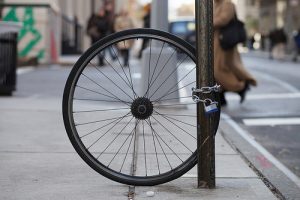Ever experienced that sinking feeling as you approach the empty rack where you left your bike chained up? It’s every cyclist’s nightmare. And with some estimates putting the number of bike thefts in London at 70,000 per year, it’s worth taking some simple steps to dramatically reduce your chances of being part of that statistic.
Location, Location, Location
The ideal place to park your bike is inside, but when this isn’t possible choose your location carefully. A busy, well lit public place with lots of footfall is best. Avoid locations that suggest the bike will be there all day (like train stations) in favour of locations that suggest you might return any minute (like outside a shop or cafe).
Wherever possible use specific cycle parking stands or racks. Don’t lock your bike to a signpost where the sign can easily be removed and the bicycle simply lifted over the top of the post.
If you need to lock your bike on the street at either end of a regular journey try not to leave your bike in the same place every day, as determined bike thieves might spot it and return with the tools of their trade at a later date.
How to lock your bike

Thieves don’t always target entire bikes, as there’s money to be made from bits of bikes too, so make sure that all of your bike, not just parts of it, are secure. Lock both wheels and the frame to a solid object. Using two different types of locks – one cable, one D-lock – is best, as thieves will most often come prepared for one type or the other, but not both.
Anything on your bike that can easily be removed including lights and cycle computers should be taken away by you, to prevent it from being taken away by someone else. Removing the saddle keeps it safe as well as making the remaining bike less attractive to thieves.
Equipment
Good locks are not particularly cheap, but they are cheaper than replacing your bike, so get the best you can afford. Your main lock should ideally be Silver or Gold rated. Choose a D-lock which fits snugly when in use. The more space left between the lock and the object it is locked to the easier it will be to break.
Quick release levers on seatposts and wheels offer zero protection, and allen key bolts offer not much more, which is why anything attached to your bike in this way should be locked to a solid object when parking it. Pinhead locks or similar offer an extra layer of security.
Make life tougher for the thieves
The police use the BikeRegister database to identify and recover stolen bikes. Registering your bike will increase the chances of being reunited with it should the worst happen, and displaying the fact that your bike is registered by way of a sticker on the frame will make it a less desirable target in the first place.
When buying a second hand bike (hopefully not because you just had one nicked) one final thing that you can do to discourage thieves is to take steps to make sure that you don’t buy a stolen bike.
There have been cases of bike theft in the press recently that have gained considerable coverage due to the unusual method applied by the thieves. Cutting through the bike rack and taping it together again so that it looked undamaged, they then returned later to steal the bike of the unsuspecting person who parked it there. As this demonstrates, thieves will go to great lengths to relieve you of your trusty steed. By following these simple tips you can make life harder for them, and so have a much better chance of avoiding that sinking feeling.
Leave a Reply